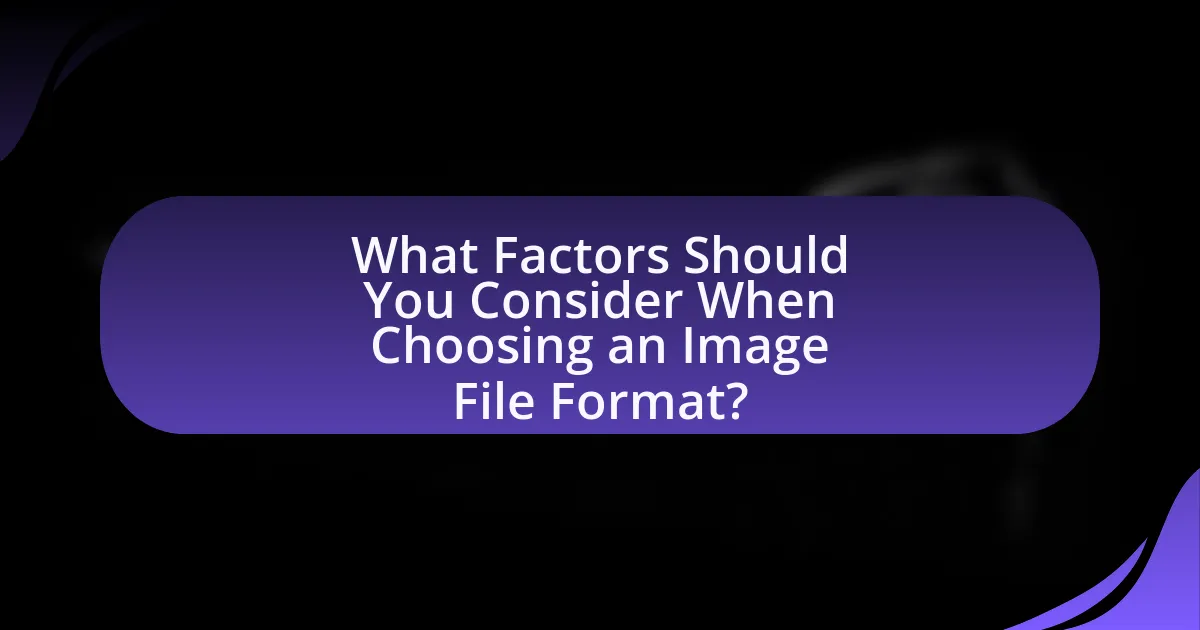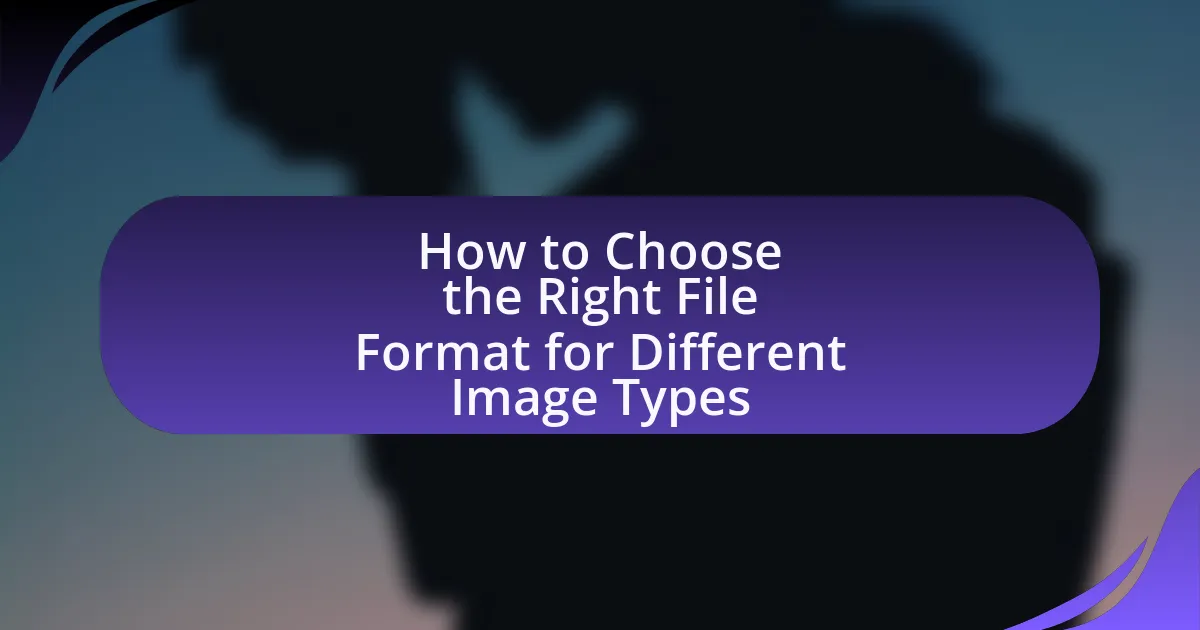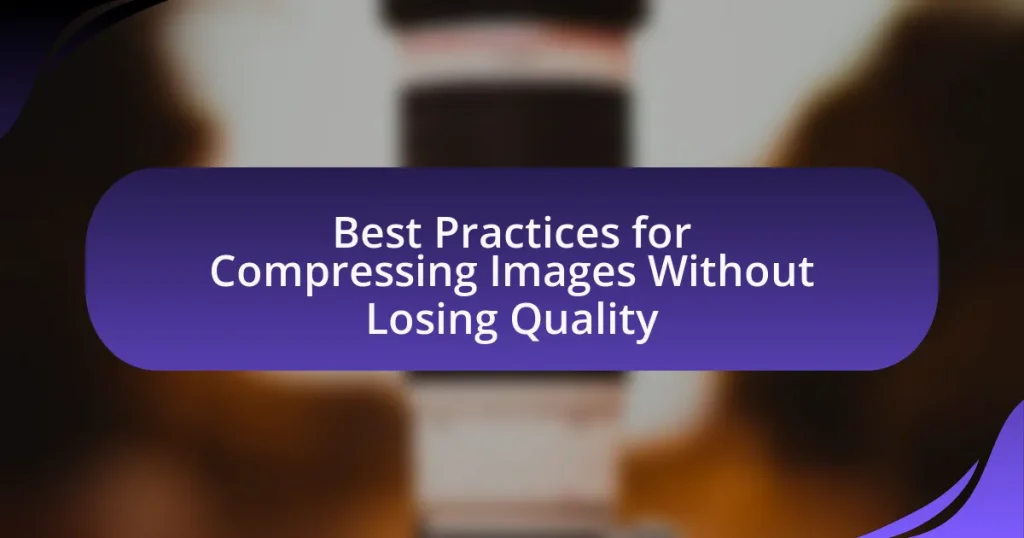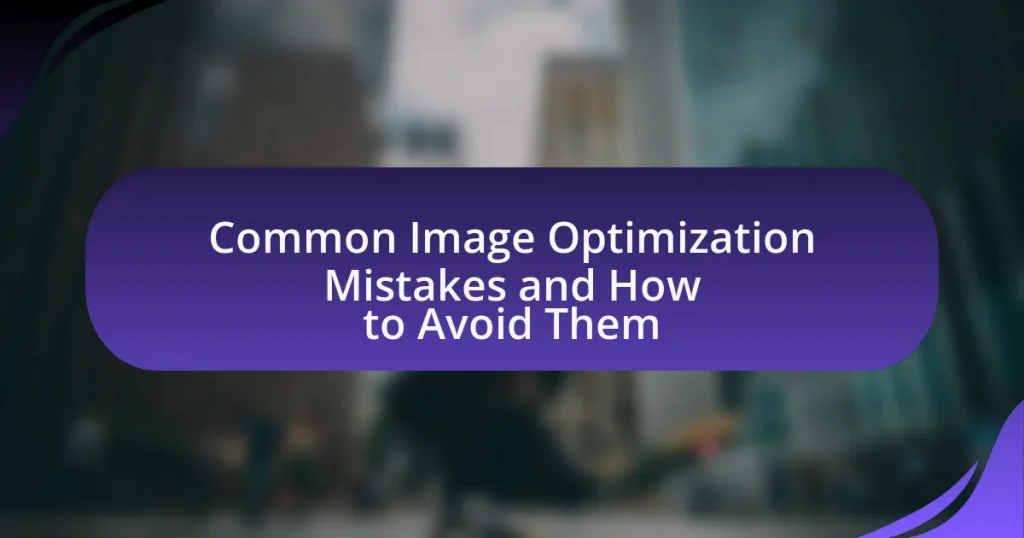The article focuses on how to choose the right file format for different image types, emphasizing key factors such as image quality, file size, compatibility, and intended use. It explains the differences between lossy and lossless compression, the impact of resolution on format selection, and the characteristics of common formats like JPEG, PNG, and TIFF. Additionally, it discusses best practices for selecting formats based on specific use cases, such as web or print media, and highlights the importance of considering future needs and compatibility to avoid potential issues. The article also provides tips for effective format selection and tools for converting between formats.
What Factors Should You Consider When Choosing an Image File Format?

When choosing an image file format, consider factors such as image quality, file size, compatibility, and intended use. Image quality is crucial because formats like PNG and TIFF support lossless compression, preserving detail, while JPEG uses lossy compression, reducing quality for smaller file sizes. File size impacts storage and loading times; for instance, JPEGs are typically smaller than PNGs, making them suitable for web use. Compatibility with software and devices is essential, as some formats may not be supported universally. Lastly, the intended use, whether for print, web, or archival purposes, dictates the best format choice, as different formats serve specific needs effectively.
How do different image file formats impact quality?
Different image file formats impact quality primarily through their compression methods and color depth. Formats like JPEG use lossy compression, which reduces file size by discarding some image data, leading to a decrease in quality, especially at higher compression levels. In contrast, formats such as PNG and TIFF utilize lossless compression, preserving all image data and maintaining higher quality, making them suitable for images requiring fine detail, such as graphics and professional photography. Additionally, formats like RAW capture unprocessed image data directly from the camera sensor, offering the highest quality and flexibility for post-processing. Studies show that JPEG can lose up to 30% of image quality at high compression, while lossless formats retain full fidelity, confirming the significant impact of file format on image quality.
What is the difference between lossy and lossless compression?
Lossy compression reduces file size by permanently eliminating some data, resulting in a loss of quality, while lossless compression retains all original data, allowing for perfect reconstruction of the original file. For example, JPEG is a common lossy format that significantly decreases image size but may introduce artifacts, whereas PNG is a lossless format that preserves image quality but typically results in larger file sizes. This distinction is crucial when choosing file formats for different image types, as it affects both quality and storage efficiency.
How does resolution affect image file format choice?
Resolution significantly influences the choice of image file format because higher resolutions typically require formats that support larger file sizes and better quality. For instance, formats like TIFF or PNG are preferred for high-resolution images due to their lossless compression, which preserves detail, while JPEG is often used for lower-resolution images because it employs lossy compression, reducing file size at the expense of some quality. This relationship is crucial for applications such as printing, where high resolution is essential, necessitating the use of formats that maintain image integrity.
What are the common image file formats available?
The common image file formats available include JPEG, PNG, GIF, BMP, TIFF, and SVG. JPEG is widely used for photographs due to its efficient compression, while PNG supports transparency and is ideal for graphics. GIF is popular for simple animations, BMP is a basic format with no compression, TIFF is favored in professional photography for its high quality, and SVG is used for vector graphics, allowing scalability without loss of quality. These formats serve different purposes based on their characteristics, making them suitable for various applications in digital imaging.
What are the characteristics of JPEG files?
JPEG files are characterized by their lossy compression, which significantly reduces file size while maintaining acceptable image quality. This compression method allows JPEG images to be easily shared and stored, making them ideal for web use and digital photography. Additionally, JPEG supports 24-bit color, enabling a wide range of colors and gradients, but it does not support transparency. The format is widely compatible across various devices and software, further enhancing its usability. JPEG files are particularly effective for photographs and images with smooth color transitions, but they may exhibit artifacts in images with sharp edges or text due to the compression process.
When should you use PNG files instead of JPEG?
Use PNG files instead of JPEG when you need images with transparency or when you require lossless compression. PNG supports transparent backgrounds, making it ideal for graphics, logos, and images that need to blend seamlessly with different backgrounds. Additionally, PNG maintains image quality without loss, which is crucial for images with text, sharp edges, or detailed graphics. In contrast, JPEG uses lossy compression, which can degrade image quality, particularly in areas with fine detail or color gradients.
What are the advantages of using TIFF files?
TIFF files offer several advantages, including high image quality, lossless compression, and extensive color depth. The high image quality is due to TIFF’s ability to store images without losing any data, making it ideal for professional photography and printing. Lossless compression ensures that the original image data remains intact, which is crucial for archival purposes. Additionally, TIFF files support a wide range of color depths, accommodating both grayscale and color images, which enhances their versatility in various applications such as graphic design and medical imaging.
How do specific use cases influence file format selection?
Specific use cases significantly influence file format selection by determining the requirements for image quality, compression, and compatibility. For instance, high-resolution images for printing typically require formats like TIFF or PNG, which support lossless compression and high color depth, ensuring that the final print maintains quality. Conversely, web images often utilize JPEG or GIF formats due to their smaller file sizes and faster loading times, which are essential for online performance. Additionally, specific applications, such as medical imaging or graphic design, may necessitate specialized formats like DICOM or PSD, which offer unique features tailored to those fields. This alignment between use cases and file formats ensures optimal performance and quality for the intended application.
What file formats are best for web use?
The best file formats for web use are JPEG, PNG, and GIF. JPEG is ideal for photographs due to its efficient compression and ability to maintain quality at smaller file sizes, making it suitable for web images. PNG supports transparency and is excellent for graphics with text or sharp edges, while GIF is commonly used for simple animations and graphics with limited colors. These formats are widely supported across browsers and devices, ensuring compatibility and optimal loading times for web content.
Which formats are ideal for print media?
The ideal formats for print media are TIFF, PDF, and EPS. TIFF (Tagged Image File Format) is preferred for its high-quality images and lossless compression, making it suitable for professional printing. PDF (Portable Document Format) is widely used for its ability to preserve formatting and compatibility across different systems, ensuring that printed materials appear as intended. EPS (Encapsulated PostScript) is favored for vector graphics and illustrations, allowing for scalability without loss of quality. These formats are commonly utilized in the printing industry due to their ability to maintain image integrity and quality during the printing process.
How do file formats affect image editing and manipulation?
File formats significantly affect image editing and manipulation by determining the quality, flexibility, and compatibility of images during the editing process. For instance, lossless formats like TIFF and PNG preserve image quality and allow for extensive editing without degradation, while lossy formats like JPEG compress images, which can lead to quality loss after multiple edits. Additionally, certain formats support layers and transparency, such as PSD (Photoshop Document), enabling more complex manipulations. The choice of file format directly influences the editing workflow, as some software may only support specific formats, impacting the ease of use and the range of editing options available.
What are the best practices for selecting the right file format?
The best practices for selecting the right file format include understanding the purpose of the image, the required quality, and the intended use. For instance, JPEG is ideal for photographs due to its efficient compression and acceptable quality, while PNG is better for images requiring transparency and higher quality. Additionally, consider the compatibility with various platforms and devices; for example, SVG is preferred for web graphics due to its scalability without loss of quality. Research indicates that using the appropriate file format can significantly enhance loading times and user experience, as seen in studies by Google on web performance optimization.
How can you determine the best format for your project needs?
To determine the best format for your project needs, assess the specific requirements of your project, including image quality, file size, and compatibility. For instance, if high-quality images are essential, formats like TIFF or PNG are preferable due to their lossless compression. Conversely, if file size is a priority, JPEG is suitable as it offers significant compression with acceptable quality loss. Additionally, consider the intended use of the images; for web use, formats like WebP or JPEG are often optimal due to their balance of quality and size. Compatibility with software and platforms is also crucial; ensure the chosen format is widely supported by the tools you plan to use.
What tools can help you convert between different image file formats?
Various tools can help convert between different image file formats, including software applications and online services. Popular software options include Adobe Photoshop, which supports multiple formats and offers advanced editing features, and GIMP, a free alternative that also allows format conversion. Online services like Zamzar and Convertio enable users to upload images and convert them to various formats without needing to install software. These tools are widely recognized for their effectiveness in handling image file conversions, making them reliable choices for users needing to switch formats.
What common mistakes should you avoid when choosing an image file format?
When choosing an image file format, avoid the mistake of not considering the purpose of the image. Different formats serve specific functions; for example, JPEG is suitable for photographs due to its compression capabilities, while PNG is better for images requiring transparency. Another common mistake is overlooking the impact of file size on loading times and storage, as larger files can slow down website performance. Additionally, failing to account for the quality loss associated with certain formats, like JPEG, which uses lossy compression, can lead to subpar image quality. Lastly, neglecting compatibility with various platforms and devices can result in accessibility issues, as not all formats are universally supported.
How can choosing the wrong format affect your project?
Choosing the wrong format can significantly hinder your project’s quality and efficiency. For instance, using a lossy format like JPEG for images requiring high detail can result in a loss of critical information, negatively impacting visual clarity. Additionally, selecting an incompatible format may lead to issues in software compatibility, causing delays and increased costs due to the need for format conversion or rework. Research indicates that using the appropriate file format can enhance loading times and overall user experience, as seen in studies on web performance optimization.
What are the implications of not considering future use cases?
Not considering future use cases can lead to significant limitations in flexibility and adaptability of file formats. When organizations fail to anticipate how their image files may need to be used in the future, they risk selecting formats that may not support evolving technologies or applications, resulting in potential data loss or increased costs for conversion. For instance, choosing a format that lacks support for high-resolution displays or advanced compression techniques can hinder the usability of images in modern contexts, such as web design or digital marketing. This oversight can also lead to compatibility issues with software updates or new platforms, ultimately affecting the accessibility and longevity of the digital assets.
What tips can help you effectively choose the right file format?
To effectively choose the right file format, consider the purpose of the image, the required quality, and the compatibility with various platforms. For instance, JPEG is ideal for photographs due to its balance of quality and file size, while PNG is better for images requiring transparency and higher quality. Additionally, TIFF is preferred for professional printing because it retains more detail. Understanding these characteristics helps in selecting the most suitable format for specific needs, ensuring optimal performance and quality across different applications.



